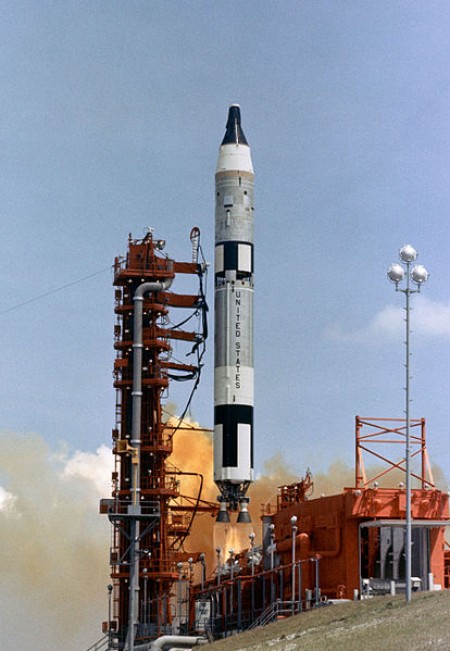Forty-nine years ago today, NASA successfully conducted the orbital mission of Gemini-Titan 1. The unmanned test marked the first time that a modified Titan II ICBM launch vehicle was used to loft a Gemini spacecraft into earth orbit.
Project Mercury was America’s first manned spaceflight series. Project Apollo would ultimately land men on the Moon and return them safely to the Earth. In between these historic spaceflight efforts would be Project Gemini.
The purpose of Project Gemini was to develop and flight-prove a myriad of technologies that were required to get to the Moon. Those critical technologies included spacecraft power systems, rendezvous and docking, orbital maneuvering, long duration spaceflight and extravehicular activity.
Gemini-Titan 1 (GT-1) was the first flight of the Gemini Program. The primary goals of the mission were to (1) verify the structural integrity of the Gemini spacecraft-Titan II booster combination, (2) exercise the program’s new tracking and communication systems, and (3) provide realistic training for Gemini ground support crews.
The Gemini I spacecraft did not carry a crew. Thus, it was not configured with a life support system nor crew seats . Rather, the vehicle carried equipment for measuring flight pressure, vibration, acceleration, temperature, and structural loads data. These test measurements were telemetered to the ground during the flight for later analysis.
The Titan II was designed as an Intercontinental Ballistic Missile (ICBM). In its new role as a manned launch vehicle, the Titan II’s reliability had to be improved substantially before commiting a human crew to flight. Like the Redstone and Atlas missiles converted for the manned launcher role in the Mercury Program, this demanding task would be successfully completed in the case of the Titan II as well.
On Wednesday, 08 April 1964, Gemini-Titan 1 lifted-off at 16:01:01.69 UTC from Cape Canaveral’s LC-19. It only took about 330 seconds for the Gemini spacecraft to be inserted into an elliptical orbit measuring 165 nm (apogee) by 87 nm (perigee). The Titan second stage would remain attached to the Gemini spacecraft throughout the mission.
The GT-1 mission was officially completed after three (3) earth orbits encompassing slightly under 5 hours of flight. However, the combined spacecraft-second stage configuration remained in space for 95 hours before reentering the earth’s atmosphere during orbit 64. By design, the vehicle did not survive the fiery reentry. Debris impact occurred in the South Atlantic around 15:00 UTC on Sunday, 12 April 1964.
Although certainly not problem free, Gemini-Titan 1 successfully satisfied mission objectives and provided confidence in both the Gemini spacecraft and the Titan II booster. Another successful unmanned mission (GT-2) would follow in January 1965. The technical know-how gleaned from these early unmanned flights led to the first manned Gemini mission (GT-3) which was successfully flown in March 1965.


